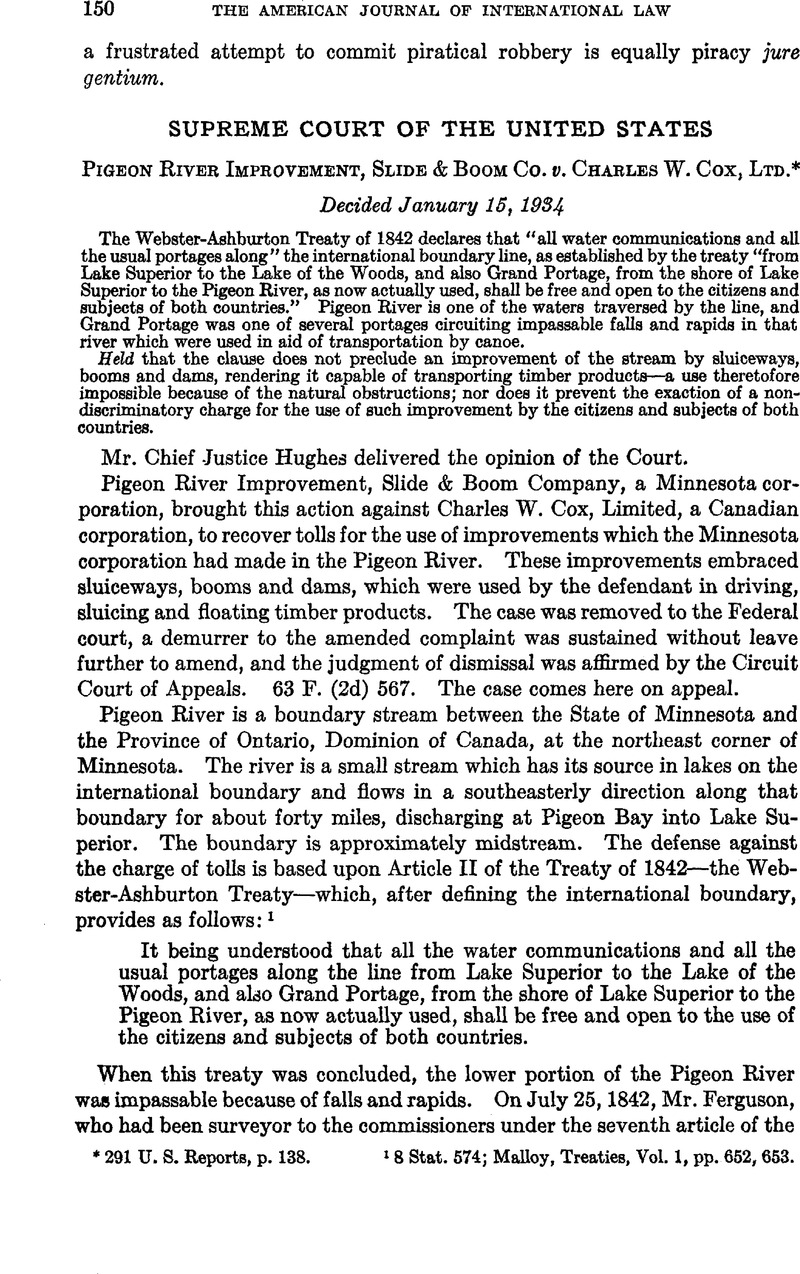No CrossRef data available.
Article contents
Pigeon River Improvement, Slide & Boom Co. v. Charles W. Cox, Ltd.*
Published online by Cambridge University Press: 12 April 2017
Abstract

- Type
- Judicial Decisions Involving Questions of International Law
- Information
- Copyright
- Copyright © American Society of International Law 1935
Footnotes
291 U. S. Reports, p. 138.
References
1 8 Stat. 574; Malloy, Treaties, Vol. 1, pp. 652, 653.
2 8 Stat. 221, 222; Malloy, Treaties, loc.cit.,pp. 617, 624.
3 Sen. Doc, Vol. 1, No. 1, 27th Cong., 3d sess., pp. 104,105. See also “The Topography and Geology of the Grand Portage,” George M. Schwartz, Minnesota Historical Bulletin, Vol. 9, p.27.
4 “The Pigeon River, which now forms the international boundary at Lake Superior, was, in the days of water transportation, the best natural highway between the Great Lakes or the St. Lawrence system, and the great northwestern section of the continent, with its thousands of lakes and streams draining into Hudson Bay or the Arctic Ocean. But the Pigeon River, through the last twenty miles of its course before it flows into Lake Superior, is so obstructed by falls and by cascades in rocky canyons as to be impossible of navigation. On the Canadian side the land is too mountainous and the distance too great for portaging to be practicable; but on the American side the line of the lake shore is roughly parallel to the river, and about seven or eight miles from the mouth of the river a little bay forms a natural harbor from which a portage of about nine miles over not too difficult country can be made to the Pigeon River above the cascades.” “The Story of the Grand Portage,” Solon J. Buck, Minnesota History Bulletin, Vol. 5, p. 14.
5 Sen. Doc, Vol. 1, No. 1, 27th Cong., 3rd Sess., p. 61.
6 For a description of the traffic carried on by means of the Grand Portage, see “The Story of the Grand Portage,” Minnesota History Bulletin, Vol. 5, pp. 15-26; “Voyages from Montreal through the Continent of North America,” Sir Alexander Mackenzie, Vol. 1, pp. lxxi, lxxvii-lxxxii; Henry-Thompson Journals, Elliott Coues, Vol. 1, pp. 6, 7; Wisconsin Historical Collections, Vol. XI, pp. 123-125, note.
7 General Laws of Minnesota, 1878, Chap. 34; 1889, Chap. 221; 1905, Chap. 89; Mason's Minnesota Statutes, 1927, secs. 7550-7552.
8 10 Stat. 1110; see, also, H.R. 51st Cong., 1st Secs., Ex. Doc. No. 247, p.59.
9 C. 878, 31 Stat. 1455.
10 See Cong. Rec, 56th Cong., 2d Sess., Vol. 34, pt. 4, p. 3462.
11 R.S.O. 1914, c. 178; R.S.O. 1927, c. 218; Lakes and Rivers Improvement Act, R.S.O. 1927, c. 43, secs. 32, 52.
12 See Treaty of September 3, 1783, between the United States and Great Britain, Art. VIII, Malloy, p. 589; Webster-Ashburton Treaty, 1842, Art. III , Malloy, p. 653; Treaty of Washington, 1871, Arts. XXVI, XXVIII, compare Art. XXVII, Malloy, p. 711; Convention concerning the Boundary Waters between the United States and Canada, 1909, Art. I, U. S. Treaties, Vol. 3, p. 2608; Treaty of Guadalupe Hidalgo, 1848, Arts. VI, VII, Gadsden Treaty, 1853, Art. IV, Malloy, pp. 1111, 1123; Moore, International Law Digest, Vol. 1, pp. 625, et seq.;Hyde, International Law, Vol. 1, secs. 160, et seq.;Oppenheim, International Law, 4th ed., sees. 178, et seq.
13 Willson v.Blackbird Creek Marsh Co., 2 Pet. 245; Gilman v.Philadelphia, 3 Wall. 713; Pound v.Turck, 95 IT. S. 459; County of Mobile v.Kimball, 102 U.S. 691; Cardwell v.American Bridge Co., 113 U.S. 205; Huse v.Glover, 119 U.S. 543; Sands v.Manistee River Improvement Co., 123 U.S. 288; Lindsay & Phelps Co. v.Mullen, 176 U.S. 126; Minnesota Rate Cases, 230 U.S. 352, 403-405; International Bridge Co. v.New York, 254 U. S. 126; Economy Light & Power Co. v.United States, 256 U.S. 113; Newark v.Central Railroad Co., 267 U.S. 377.
14 30 Stat. 1151.
15 See United States v. Rio Grande Irrigation Co., 174 U.S. 690, 707, 708; Leovy v.United States, 177 U.S. 621,628; Economy Light & Power Co. v.United States, 256 U. S. 113, 123, 124; Wisconsin v.Illinois, 278 U.S. 367, 412, 413.
16 See Note 9.
17 36 Stat. 2448, U.S. Treaties, Vol.3, p.2607.
18 Article I of the Treaty of 1909 is as follows:
“The High Contracting Parties agree that the navigation of all navigable boundary waters shall forever continue free and open for the purposes of commerce to the inhabitants and to the ships, vessels, and boats of both countries equally, subject, however, to any laws and regulations of either country, within its own territory, not inconsistent with such privilege of free navigation and applying equally and without discrimination to the inhabitants, ships, vessels, and boats of both countries.
“It is further agreed that so long as this treaty shall remain in force, this same right of navigation shall extend to the waters of Lake Michigan and to all canals connecting boundary waters, and now existing or which may hereafter be constructed on either side of the line. Either of the High Contracting Parties may adopt rules and regulations governing the use of such canals within its own territory and may charge tolls for the use thereof, but all such rules and regulations and all tolls charged shall apply alike to the subjects or citizens of the High Contracting Parties and the ships, vessels, and boats of both of the High Contracting Parties, and they shall be placed on terms of equality in the use thereof.”


